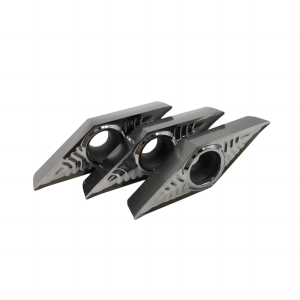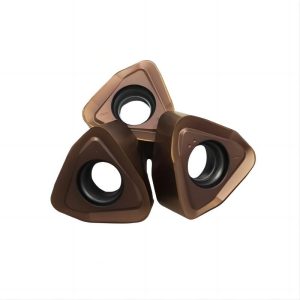When it comes to machining, choosing the right carbide inserts for hard and soft materials is essential for optimal performance and tool life. Carbide inserts are widely used in industries such as automotive, aerospace, and heavy manufacturing due to their precision, durability, and ability to withstand high temperatures. In this guide, we’ll walk you through how to choose the best carbide inserts for your specific needs.
Carbide inserts are cutting tools made from tungsten carbide, a material known for its exceptional hardness and wear resistance. These inserts are used for turning, milling, drilling, and other cutting operations. The inserts are designed to provide sharp cutting edges that stay durable even under extreme conditions, ensuring high-quality performance in machining operations.
External Link Idea: Learn more about Tungsten Carbide
Key Factors Influencing Carbide Insert Selection
When selecting carbide inserts, there are several factors to consider to ensure you get the best performance for your specific application. These factors include:
- Material Hardness: Different materials require different carbide insert properties. Hard materials require inserts with high toughness and wear resistance, while softer materials may need inserts that maintain a sharp cutting edge.
- Insert Geometry: The shape and angle of the insert affect cutting efficiency, surface finish, and tool life.
- Coatings: The coating of the carbide insert can improve wear resistance, reduce friction, and increase tool life.
External Link Idea: Carbide Inserts: How to Choose the Right One
Selecting Inserts for Machining Soft Materials
Soft materials like aluminum, brass, and copper require inserts that allow for smooth, efficient cutting without damaging the workpiece. For soft materials, uncoated carbide inserts are often preferred because they offer sharp cutting edges that can achieve clean, smooth cuts.
Recommended Insert Features for Soft Materials:
- Geometry: Inserts with a sharper edge and positive rake angles work best for soft materials.
- Grade: Choose a carbide grade with lower wear resistance and higher toughness to handle the softer cutting conditions.

Boyo carbide inserts for soft material machining provide sharp edges for smooth cuts.
Choosing Inserts for Hard Materials
Machining harder materials such as stainless steel, high-carbon steels, and titanium alloys requires inserts that can withstand high cutting forces and temperatures without breaking or wearing out prematurely.
Recommended Insert Features for Hard Materials:
- Geometry: Inserts with a more robust geometry, including smaller negative rake angles, help withstand higher forces.
- Grade: Use a carbide grade with high wear resistance and toughness, capable of handling the thermal stresses produced during cutting.
- Coatings: For harder materials, coatings such as TiN (Titanium Nitride) or CVD (Chemical Vapor Deposition) coatings help extend tool life by reducing wear and heat buildup.

Boyo carbide inserts with special coatings designed for hard material machining offer durability and precision.
Carbide Grades: Matching Grades to Applications
Selecting the right carbide grade is crucial for maximizing the tool’s performance and longevity. Carbide inserts come in various grades, each designed for specific applications. The hardness, toughness, and wear resistance of each grade determine how well it performs in different cutting environments.
Common Carbide Grades:
- P Grades (for Steel): Ideal for cutting steel and other ferrous materials.
- K Grades (for Cast Iron): Perfect for cutting cast iron, which is often abrasive.
- M Grades (for Stainless Steel): Recommended for machining stainless steels and other hard alloys.
Coated vs. Uncoated Inserts: Pros and Cons
The decision to use coated or uncoated carbide inserts depends on the material being machined and the specific requirements of the cutting operation.
Coated Inserts:
- Advantages: Coated carbide inserts have a thin layer of material applied to the surface, which enhances wear resistance and reduces friction. Coatings such as TiAlN (Titanium Aluminum Nitride) or CVD coatings are ideal for high-speed machining and hard materials.
- Best For: High-heat applications and machining harder materials.
Uncoated Inserts:
- Advantages: Uncoated inserts provide sharp cutting edges and are often more cost-effective than coated inserts. They are ideal for softer materials where friction and wear are less of a concern.
- Best For: Soft materials like aluminum and brass, or where sharpness is a priority.
External Link Idea: Carbide Inserts: Coated vs. Uncoated
Understanding Insert Geometry: Rake Angles, Nose Radii, and More
The geometry of a carbide insert plays a significant role in its cutting performance. Key factors include rake angles, nose radii, and insert shapes.
- Rake Angles: The angle at which the insert engages the workpiece affects cutting efficiency and surface finish. Positive rake angles are ideal for softer materials, while negative rake angles are better suited for hard materials.
- Nose Radius: A larger nose radius provides better durability and surface finish, while smaller radii offer better precision for detailed cuts.
Carbide inserts with different geometries provide various benefits for cutting performance and tool longevity.
Practical Tips for Optimizing Insert Performance
To get the most out of your carbide inserts, follow these tips:
- Adjust Cutting Parameters: Ensure you use the correct cutting speed, feed rate, and depth of cut based on material hardness and insert specifications.
- Monitor Tool Wear: Regularly check the condition of your inserts and replace them when necessary to maintain cutting precision.
- Coolant Use: Use appropriate coolants to reduce heat buildup during cutting, especially when working with hard materials.
External Link Idea: How to Optimize Tool Life
Choosing the best carbide inserts for hard and soft materials is a balance between material properties, tool geometry, carbide grades, and coatings. Understanding the key factors that influence insert selection ensures that your machining processes are efficient, cost-effective, and precise.
If you’re looking for carbide inserts that offer high durability, precision, and excellent performance for both hard and soft materials, Boyo Cutting Tools is here to provide high-quality solutions tailored to your needs. Our carbide inserts are designed to meet the demanding requirements of industries such as aerospace, automotive, and manufacturing.
Get in touch with Boyo Cutting Tools today to discuss your carbide insert requirements and get a custom quote. Let us help you improve your machining operations with high-performance, long-lasting carbide inserts.

